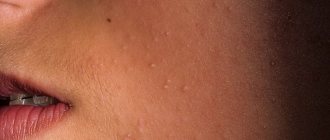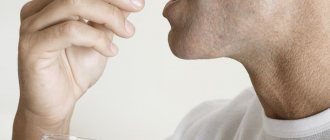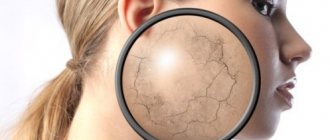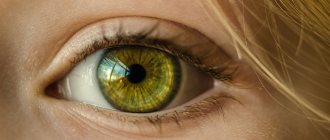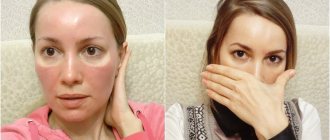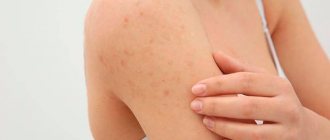Peeling of the skin represents an accelerated process of necrosis of body surface cells with their exfoliation, which significantly worsens the appearance of the skin, disrupting the natural balance of tissue regeneration. Due to the influence of many reasons, such changes are observed, contributing to excessive drying of the surface and active rejection of epithelial cells.
The visual characteristics of peeling represent the presence of small scales of the epidermis in certain areas of the skin, which manifests itself regardless of the type of skin, be it oily or combination. But most often people with dry skin suffer from such symptoms, when the root cause of peeling is genetically determined.
Make an appointment with a dermatologist by phone or by filling out the online form
| Select a clinic | Rash on back | Rash on cheeks | Rash on elbows |
Why does skin peeling occur?
A disruption in the natural balance of renewal of the cellular structures of the skin can be observed for a number of reasons, the impact of which provokes a pathological deviation. Among them, the following should be highlighted:
- changes in ambient temperature;
- manifestation of an allergic reaction to the external use of care products;
- existing skin diseases;
- unbalanced diet, which is associated with the lack of fat-soluble vitamins necessary for the skin;
- natural aging of the surface layer;
- hereditary predisposition.
Thus, the causal effect contributes to a change in the ratio of the rate of keratinization of epithelial cells with their rejection, which leads to the manifestation of typical signs of skin peeling:
- itching;
- change in skin turgor;
- the appearance of a hint of hyperemia;
- presence of relative pain syndrome;
- formation of small cracks on the surface.
The principle of combating the manifestations of peeling
In certain cases, the appearance of pathological detachment of the epidermal layer develops against the background of the following diseases, which require specific treatment to eliminate the cause of the development of the pathology, and as a result, peeling of the skin disappears:
- seborrheic skin lesions;
- psoriasis;
- systemic lupus erythematosus;
- ichthyosis;
- dry erythema;
- ringworm and its varieties;
- scarlet fever;
- skin damage due to fungal infection and other conditions.
The development of pathology can be stopped on your own by using appropriate products for local application, maximally nourishing and moisturizing areas of the skin that are subject to the process of active exfoliation. In case of nutritional disorders, additional intake of fat-soluble vitamins helps restore the natural balance of cell layer renewal.
But if the condition worsens or the cause of the signs of pathology is unclear, you should consult a dermatologist who will competently conduct a diagnostic examination, which will help determine the most appropriate course of treatment. The main goal of diagnostics in this case is to exclude the presence of an infectious pathogen of any kind, which requires the subsequent use of specific treatment.
Useful information on the topic:
- Calling a dermatologist to your home
- Fungal infections
- Rash on the body
- Sexually transmitted diseases
- How to get tested
- Wart removal
- Removal of condylomas
- Tests for STIs
- Removal of papillomas
- Skin rash
- Pyoderma
- Skin structure
- Mushroom tests
- Diagnosis of sexually transmitted infections
Medicines to treat eczema
To treat eczema of neurogenic pathogenesis, sedatives such as sleeping pills and sedatives are prescribed. To eliminate the allergic component, antihistamines must be prescribed. The best results are achieved by combination therapy [3].
To relieve the external manifestations of eczema, it is necessary to use creams on the affected areas of the skin. Akriderm® creams and ointments act systemically, reducing swelling and itching [4, 5, 6], moisturizing the skin and eliminating flaking [4].
The following medications are used to treat eczema on the hands and feet:
- "Akriderm GK" based on betamethasone dipropionate, gentamicin, clotrimazole - for different types of eczema. Medicinal cream and ointment "Akriderm GK" act on the source of inflammation and infection. The agents have anti-inflammatory, antiallergic, antifungal and antibacterial effects [5].
- "Akriderm Genta" based on betamethasone dipropionate, gentamicin and methyl parahydroxybenzoate - especially for coin-shaped, childhood, atopic eczema [6].
- Akriderm SK ointment based on betamethasone dipropionate and salicylic acid with keratolytic and antiseptic effects is an ointment for various types of eczema [4].
The use of medications internally, ointments and creams for external application to the affected skin and compliance with other recommendations of the attending physician helps to more effectively defeat eczema and prolong the remission stage. At an early stage of the disease, topical remedies may be sufficient. It is also necessary to adhere to the rules of hand and foot hygiene, take baths with warm water and use only hypoallergenic detergents.
What diseases cause skin peeling?
There are many reasons that cause peeling skin. These include both ordinary allergies and more complex skin diseases. Dermatological diseases can be infectious or non-infectious. These include:
- Hereditary disease ichthyosis;
- Diseases of internal organs;
- Psoriasis;
- Dermatitis manifested in seborrhea;
- Lupus erythematosus;
- Fungal diseases of an infectious nature;
- Syphilis in secondary manifestations;
- Pityriasis rosea;
- Scarlet fever;
- Dry erytherma;
- Mycosis and xerosis.
With ichthyosis, the skin has a characteristic grayish tint. Its surface is covered with small scales. The patient experiences discomfort. His skin is peeling and itching. For this disease, no chemicals should be used. Even regular soap causes redness and irritation.
The main causes are sunburn, infections, HIV problems, dry skin in psoriasis, and skin injuries. Medicines play an important role. Seborrheic dermatitis occurs as a consequence of changes in the functioning of the skin. Sebum will be released in large quantities. This leads to progression of the disease.
Pityriasis rosea appears due to low levels of the body's immunity. This may be hypothermia of the dermis, insufficient nutrients. A cold or flu also worsens the condition of the body. It begins to react sensitively to external irritants in the form of soap, lotions, and other cosmetics. Cold wind, frost or hot weather increase pain.
Secondary syphilis appears as a skin rash. These invisible spots cause general malaise. The patient has a headache and a fever. Lymph nodes become larger. Peeling occurs suddenly. The deep layers need moisture. No amount of cosmetics can correct the situation. Treatment measures will give results if we find out the exact cause.
Symptoms
Symptoms of hand-foot syndrome and hand-foot skin reaction may appear 3 to 6 weeks after starting chemotherapy. Depending on the medicine you are taking, any of the following symptoms may appear on your palms and soles of your feet:
- sharp tingling or burning-like pain, especially in the tips of the fingers and toes;
- dry, cracked, scaly or flaky skin;
- thickened skin that looks like a callus;
- mild or pronounced redness;
- edema;
- blisters;
Symptoms of palmoplantar skin reaction usually appear on parts of the body that are subject to a lot of pressure, such as the balls of the toes, between the toes, and the sides of the feet.
Symptoms of hand-foot syndrome and hand-foot skin reaction can range from mild discomfort to a painful sensation that can prevent you from doing normal activities. You may have difficulty grasping small objects such as a pen or fork. It may be difficult to fasten buttons on clothes. Some people have difficulty walking.
Symptoms usually go away when the dose of chemotherapy is reduced or when the course of treatment is completed. The skin begins to recover after a few weeks.
to come back to the beginning
What tests need to be taken for peeling skin?
Deterioration of the condition of the skin can occur as a result of the use of bad cosmetics. In this case, it is enough to change your skin care system. But if the reasons are deep-rooted, then you must undergo a series of tests:
- General blood test. Necessary for identifying problems of an infectious nature, vitamin deficiency and anemia. This type of diagnosis allows you to identify helminths. They have a toxic effect on the body. This leads to deterioration of the dermis;
- Complete (biochemical) blood test. Its results make it possible to identify disturbances in the functioning of internal organs. You can find out what elements the body lacks for full development. For example, vitamins A and B affect skin condition. Their lack leads to flaking and dryness. Poor functioning of the kidneys, liver, stomach and all parts of the gastrointestinal tract also negatively affects our face, chin and other areas of the body.
- Blood test for general immunity level and determination of allergic reactions. A good allergy test can accurately find a specific allergen;
- Mycological examination. Prescribed to identify fungal infections in seborrheic dermatitis and pityriasis rosea;
- Histological examination. A scraping of the skin is taken in advance.
If a patient is suspected of having hormonal disorders, the doctor will refer you for a consultation with an endocrinologist. This specialist will determine the lack of hormones by ordering tests to determine thyroid hormones, estrogens (in women), and DHEA. With such an extensive examination, all causative factors can be determined. Draw up the correct treatment regimen. Develop a number of preventive recommendations.
Diagnostics
Since skin itching is caused by a variety of reasons, specialists from various medical fields are involved in identifying them: dermatologists, parasitologists, trichologists, allergists-immunologists, ophthalmologists, endocrinologists. The nature of the itching can be assumed based on the collected history, localization, and the presence of skin elements (vesicles, papules, pustules, scales, excoriations, crusts). Taking into account the suspected etiology, the examination may include:
- Examination of the skin and scalp.
It is carried out using a Wood's lamp, dermatoscope, trichoscope. Allows you to conduct a visual assessment of skin elements, hair condition, and identify the presence of parasites. Scales and questionnaires are used to measure the severity of itching. - Laboratory diagnostics.
If a systemic nature of skin itching is suspected, the level of thyroid hormones, glucose, liver enzymes, urea and creatinine in the blood is determined. They perform microscopy of skin scrapings, stool analysis for helminth eggs, and spectral analysis of hair for the content of vitamins and heavy metals. Markers of viral hepatitis and HIV infection are studied. - Ophthalmological diagnostics.
A basic examination includes biomicroscopy of the eye, fundus examination, and tonometry. An instillation test with fluorescein is used as an additional method. - Allergy diagnostics.
The main methods for identifying allergies are blood tests (individual allergens, histamine, total IgE) and skin allergy tests for atopy antigens (prick test, prick tests). - Other examinations.
To exclude damage to internal organs as the cause of skin itching, an ultrasound of the hepatobiliary system and kidneys is performed. In unclear cases, a skin biopsy is required.
Examination by a dermatologist
What diet is necessary for peeling skin?
Balanced hypoallergenic diets will help fight the disease. First of all, you need to identify those products that cause painful reactions. Eliminate chocolate candies and bars from your daily diet. Citrus fruits, raspberries, strawberries, pomegranate, melon, black currants can also cause dryness. Honey, fish, nuts, mushrooms, cocoa, caviar are included in the list of such products.
Salads seasoned with vegetable oil have a healing effect. You should include porridge, eggs, dairy products, carrots, tomatoes, liver, and seeds. These products help increase the level of vitamins A and E. The lack of vitamin B can be compensated by unrefined cereals, green vegetables, avocados, bananas, carrots, walnuts, and cod fish liver.
Peeling of the skin due to gastrointestinal diseases
Painful signs associated with disturbances in the functioning of the gastrointestinal tract are immediately reflected in the condition of the skin:
- Gastritis and stomach ulcers cause acne, unnatural skin color, acne scars, greasy or dry skin;
- Diabetes, pancreatitis lead to itching, dryness, allergic reactions;
- Hepatitis and liver pathologies become the causes of the formation of age spots, jaundice, pimples, blackheads, asterisks, furunculosis;
- Gallbladder diseases contribute to the development of pimples, blackheads, jaundice, age spots;
- Duodenal ulcers, dysfunctions of the small intestine manifest themselves in unhealthy complexion, pimples, acne, allergic disorders, sagging, dryness;
- Constipation, diarrhea, disturbances in the functioning of the large intestine lead to fungal infections, sagging, dryness, acne, pimples and allergic spots.
If painful changes are detected, you should reconsider your diet. Consult a doctor for help, create an individual digestive program.
Common symptoms and manipulations in dermatology:
- Skin rashes
- Calling a dermatologist to your home
- Itching in the urethra
- Itchy skin
- Skin rash
- Prevention of casual sex
- Skin neoplasms
- Pyoderma
- Pityriasis rosea
- Streptoderma
- Scabies
- Peeling skin
- Fungal infections
- Skin infection
- Pus on the skin
- Blisters on the skin
- Papillomas on the foreskin
- Sexually transmitted diseases
- Skin structure
Causes of itchy skin
Itching of the scalp
Caused by diseases of the hair and scalp. It is accompanied by a feeling of skin tightness, scaly desquamation of the epidermis (dandruff), increased oiliness of the hair, excess sebum production, fragility, and sometimes hair loss. Itchy scalp can be caused by incorrectly selected care and styling products (shampoo, conditioner, hairspray). The most common pathological causes of itchy scalp include:
- pathology of the sebaceous glands: dandruff, seborrhea (oily, dry, mixed);
- parasitic diseases: head lice, demodicosis, flea bites, bedbugs;
- mycoses: favus, trichophytosis, microsporia;
- hair shaft abnormalities: idiopathic trichoclasia, knotty hair;
- autoimmune pathologies: psoriasis, SLE, scleroderma;
- other dermatoses: pityriasis versicolor pilaris (Devergie's disease), allergic dermatitis of the scalp;
- general diseases: hypovitaminosis A, heavy metal intoxication, hypothyroidism.
Itchy skin
Body itching
The causes of skin itching can be dermatological and systemic diseases. In some cases, body itching is caused by simple lack of personal hygiene: rarely taking a bath or shower, wearing dirty clothes. On the other hand, itchy skin can occur with infectious and parasitic dermatoses that are contagious to others. Itchy dermatoses are often found in older people (senile itching) and pregnant women. Dermatological diseases that most often cause itchy skin include:
- inflammatory lesions: prickly heat, seborrheic dermatitis, eczema, lichen planus, acne;
- skin infections: herpes, pyoderma, folliculitis, dermatophytosis;
- acariases and entomosis: scabies, demodicosis, pediculosis, insect allergy;
- chronic autoimmune dermatoses: psoriasis, dermatomyositis, Dühring's dermatitis herpetiformis, pemphigoid, pemphigus vulgaris;
- allergic dermatoses: urticaria, prurigo, allergic contact dermatitis, neurodermatitis;
- genodermatoses: ichthyosis, Darier's disease, Haley-Hailey disease;
- skin tumors: leukemides, Sezary syndrome, mycosis fungoides and other T-cell lymphomas of the skin.
Itching of the whole body can be a side effect of taking certain drugs: ACE inhibitors, anti-gout, antiarrhythmics, hormonal drugs, opioids. Systemic diseases occurring with chronic skin itching:
- endocrinopathies: diabetes, hypothyroidism, thyrotoxicosis;
- diseases of the hepatobiliary system and kidneys: cholestasis, cirrhosis of the liver, chronic hepatitis, chronic renal failure;
- infections: HIV, helminthiasis;
- hematological diseases: mastocytosis, leukemia, polycythemia, myeloma, lymphogranulomatosis;
- mental disorders: OCD, depression, dermatozoal delirium.
Itching in the eye area
My eyelids can itch due to any of the listed skin, infectious and general somatic pathologies. However, more often the causes of itching in the eyes are ophthalmological diseases and visual strain. People who use contact lenses, work in contact with dust and chemicals without proper eye protection, and patients with allergies and immunodeficiencies are at risk of developing such a problem. Causes of itchy eyes:
- injuries: foreign bodies, burns, mechanical damage;
- inflammatory diseases: blepharitis, conjunctivitis, meibomitis, barley, keratitis;
- parasitic lesions: demodicosis, dirofilariasis;
- allergies: eyelid dermatitis, hay fever;
- other eye diseases: dry eye syndrome, computer vision syndrome, glaucoma, cataracts.
Peeling skin in children
The thickness of the top layer of skin in children is less than in adults. And therefore the causes of dryness are much greater:
- Prolonged exposure to the sun;
- Cold wind currents;
- Negative effects of soaps, shampoos and other care products;
- Lack of vitamins;
- Constant nervous disorders and stress;
- Infectious problems.
Children often experience chamomile, lichen, fungal infections, dermatitis, and eczema. Cases of hereditary diseases cannot be excluded.
All this is a consequence of poor nutrition and hygiene procedures based on low-quality products. Only a specialist can identify the causative factors. Therefore, as soon as parents see characteristic changes in the condition of the skin, it is necessary to seek help from a dermatologist.
Signs of skin xerosis
In addition to active peeling, a person with an imbalanced moisture balance in the epidermis may experience the following symptoms:
- increased sensitivity, itching, irritation;
- feeling of tightness, burning, discomfort;
- redness of the skin;
- narrowed or enlarged pores;
- rough, uneven surface of the epidermis.
If not properly cared for, dry skin is often found on the elbows and feet: this is where the smallest number of sebaceous glands are located. The situation worsens after a long stay in the open sun, in the cold or in a room with central heating, where the air contains a minimal amount of moisture.
Peeling skin in pregnant women
Skin with a dry surface indicates a lack of water in the body of a pregnant woman. The sebaceous glands do not work as actively. The thyroid gland may produce less hormones. Which is also a reason to see a doctor.
Sometimes a woman does not pay attention to such problems. Such inattention can lead to allergic reactions. Which are transmitted from mother to unborn baby. You need to see a doctor. Get examined and follow all medical recommendations.
Dryness itself cannot adversely affect the development of the fetus. But it can bring a lot of problems to a pregnant woman. Unsightly stretch marks appear. Microcracks and dandruff form in the hair. The body is itchy and itchy. For effective treatment, you should stop taking hormonal medications. Remove cosmetics containing aggressive substances from hygiene procedures.
It is not recommended to cleanse the skin with compounds that contain alkalis. Drinking clean water can eliminate problems such as itching and flaking. When caring for your skin, be sure to use nourishing oils. Choose cosmetics that contain natural substances. This causes a softening, sunscreen effect. Use liquid soap.
Why does my face peel?
Most often, women are interested in how to deal with the abundant separation of dead cells on the face. Doctors attribute this to the difference in the functioning of the sebaceous glands, compared to men and children.
The most common catalyst for an itchy and flaky face is a lack of sex hormones, which affects the elasticity of the skin. The level of the female sex hormone estrogen decreases during menopause and during internal failures. The situation is aggravated by inappropriate care products that worsen the appearance of the neck.
If you have sensitive skin, dandruff, as well as flaking of various locations, will be visible all year round. In order not to worsen their health, such patients even have to give up the usual drying with a towel. Instead, to avoid rashes in exposed areas, they are recommended to blot the body with a soft rag or napkins.
The easiest way to correct the situation is when it comes to peeling of cells in the surface layer of skin on the face and lower legs caused by vitamin deficiency. It is enough to simply take care of enriching the diet by including fresh vegetables and fruits in the daily menu that do not cause allergies in the patient.
You will also need to use vitamin and mineral complexes, which will also help remove acne. A trip to a cosmetologist will complete the picture. The specialist will recommend the best nourishing creams and folk remedies that are suitable for the specific person.
There are often cases when it turns out that the face is covered with rough scales due to an allergic reaction. It usually also includes redness. Irritation occurs not only due to aggressive toners or facial sprays, but even after sunbathing due to contact with open ultraviolet radiation.
To prevent the formation of white plaque, you should follow a few simple recommendations:
- use only delicate products with a hypoallergenic effect;
- apply moisturizer after each wash;
- Use sunscreen according to the season.
Moreover, to increase its productivity, you will have to apply UV protection about half an hour before you are supposed to leave the room, this way you can prevent premature pigmentation, and your dermatologist will help you choose the right face cream.
Particular caution should be exercised when the eyelids are dry and covered with scales. In most cases, the presented clinical picture indicates a symptom of serious diseases, among which is trichinosis, which is caused by worms.
No less dangerous is the formation of a spot, which indicates incipient demodicosis. A little less often, the main culprit of swollen eyelids, in which a burning sensation is felt, is the eyelash mite.
In order not to wait until the moment when the problem gets out of control, you should immediately seek qualified help after discovering alarming signs. This is confirmed by numerous reviews of people who put off visiting a doctor for too long, which significantly worsened their quality of life. It is especially dangerous to delay the treatment of abnormalities in the upper and lower eyelids during pregnancy, adolescents, children, and adults with chronic diseases such as diabetes.
And even more so, you should not try to look for practical recommendations through the forum. Only a doctor can determine whether a patient has been infected by dangerous microorganisms or is lacking vitamins based on test results. He will also tell you how to eliminate the external manifestations of the disorder by drawing up an individual treatment course.
Types of skin peeling
With skin disorders, different types of peeling may occur:
- Pityriasis;
- Lamellar;
- Large-plate.
The characteristic features of the first type are small scales. But they cover the entire surface, forming different shades. It all depends on the presence of certain disorders within the body. Silvery-white scales occur with psoriasis. Yellowish - a consequence of seborrhea. Dark ones are formed when the disease is ichthyosis.
Lamellar peeling is accompanied by the formation of larger scales. In the large-lamellar form, rejection of the stratum corneum in entire layers is observed.
Prevention for peeling skin
Preventive measures for this disease are the first steps. You should pay close attention to your diet. After washing in the bath or shower, you need to use cosmetics that soften the skin. In cold weather it is necessary to protect yourself from wind and frost.
If you cannot solve the problems yourself, then seek the help of a specialist.
Methods for diagnosing skin diseases:
- Diagnosis of skin diseases
- Diagnosis of skin diseases at home
- Diagnosis of allergic skin diseases
- Diagnosis of bacterial skin diseases
- Diagnosis of viral skin diseases
- Diagnosis of hair diseases
- Diagnosis of nail diseases
- Diagnosis of skin tumors
- Blisters on the skin
- Dermatoscopy
- Demodex tests
- Diagnosis of sexually transmitted infections
- Mushroom tests
- Skin scraping
Call a dermatologist at home for peeling skin
Calling a doctor to your home will solve many problems. The patient does not have to make an appointment. He will be able to invite a specialist at a convenient time. In a home environment, it will be easier to talk about your problems. A dermatologist will be able to find out all the reasons related to the patient’s lifestyle. Draw up a treatment regimen after identifying all causative factors. In a confidential conversation, it would be better to offer recommendations on the use of cosmetics.
Benefits of a private medical appointment
The result of seeking help from a dermatologist at a private specialized institution is the provision of not only advisory assistance at the appointed time, but also a full range of examinations with further implementation of the necessary treatment procedures. This fact greatly facilitates the implementation of all actions and provides comfortable conditions for completing the prescribed procedures.
And our Help Desk for private clinics in Moscow “Your Doctor” will help you find the right medical center that is convenient for visiting, which contains all the required data, allowing you to immediately make an appointment at a suitable time or arrange a call to a dermatologist at home.
Publication date: 2020-01-07
Useful information on the topic:
- Diagnosis of skin diseases
- Treatment of skin diseases
- Dermatology - the science of skin diseases
- How to consult a dermatologist
- Prevention of skin diseases
- Dermatologist appointment
- Examination by a dermatologist
- Pediatric dermatologist
- Skin doctor
- Paid dermatologist
This article is posted for educational purposes only and does not constitute scientific material or professional medical advice.
